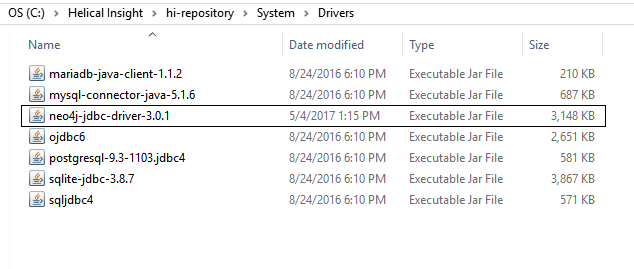

- Download neo4j java driver jar install#
- Download neo4j java driver jar drivers#
- Download neo4j java driver jar full#
- Download neo4j java driver jar code#
- Download neo4j java driver jar password#
On the driver edit dialog you need to enter all required information: Main parameters Just click the button New and create a new driver. Or from Database Navigator drop-down menu. You can open the driver manager from the main menu: Adding driver configuration in DBeaver Open driver manager dialog Sometimes the jar files are included in the database server distribution - in that case you need to refer to your database documentation or ask your DBA. You need to download the driver's jar files before adding them to DBeaver.
Download neo4j java driver jar code#
The Jar file is a library which contains program code and some other files. The JDBC driver consists of one or multiple jar files. The JDBC driver is usually provided by database vendors to allow customers to work with their databases. It usually provides all needed functionality to cover 100% of database functionality. JDBC driver is a program (in Java) which can connect and operate with some local or remote database server.
Download neo4j java driver jar drivers#
You can use a pre-configured database driver or create a new driver.ĭBeaver has a lot of pre-configured drivers including SQL, NoSQL, key-value databases, graph databases, search engines, etc.īut sometimes you need to connect to a database which was not configured in DBeaver yet.Īll you need is a JDBC driver of your database.

ReinstallJava Ĭonnecting to the database mongo=JavaNew I'm still amazed by the possibilities offered by JLink. Here's the proof of concept that should allow a lot of fruitful things. Things get a bit tricky for more complex queries that return graphs but above gives the structure for connecting and querying.įor MongoDB instead of using the Rest interface using urls as suggested by Mike, you can use the Java driver. The output is JSON so tmp2 = ImportString], "JSON"] \"BusinessProcess\", \"CONTAINS\", \"Process\" ], [ \"BusinessProcess\ "MATCH (a)->(b)RETURN DISTINCT head(labels(a)) AS This, type(r) AS To, Make sure all is working 127.0.0.1:7474Įxamples: URLFetch[" , start Neo4j (installation in usr/local/bin) $ neo4j startĤ. start the webserver $ sudo apachectl startģ. Mathematica can also connect to Neo4J via the REST API. Add your instructions using the "Body" option for URLFetch. I've been using RESTHeart for the past few months and find that a better API.
Download neo4j java driver jar password#
Also forgot to mention that for easy option A, or similar database providers, if you can enter the login and password as part of the query string then you can use Import to read from, and write to, the database. You are now in business and can read from and write to your local MongoDB from Mathematica using URLFetch.įorgot to mention that you use ImportString to convert the JSON to rules.

Download neo4j java driver jar full#
Full REST capabilities can be achieved with an external tool such as sleepy mongoose.
Download neo4j java driver jar install#
The problem with the install is that the bundled REST interface does not allow inserting etc. For the intended application there were no noticeable problems, slowdowns etc.Ģ Start the webserver $ sudo apachectl startĤ Check that everything is working on port 28017 127.0.0.1:28017 I have no idea of performance issues of the REST API vs purpose built JLink connector. For me as a non-Java programmer this was far more straight forward than trying to make a JLink connector. To interface with Mathematica I have used the REST API. I do not imagine that the set up would be too different on other systems. I have installed MongoDB on my Mac and got it working with Mathematica using this method: While I have not tested it, it seems to me that you should be able to make calls to a set up such as this from a free CDF (it is my understanding that you can import from a URL from free CDF). With this supplier you can both read from and write to the database using HTTP GET and simple query strings. One working example used a third party Mongo supplier such as 28msec.io and use URLFetch e.g. AFAIK much of this would also apply to similar DBs such as CouchDB. Here are the two ways I have successfully used MongoDB with Mathematica.


 0 kommentar(er)
0 kommentar(er)
